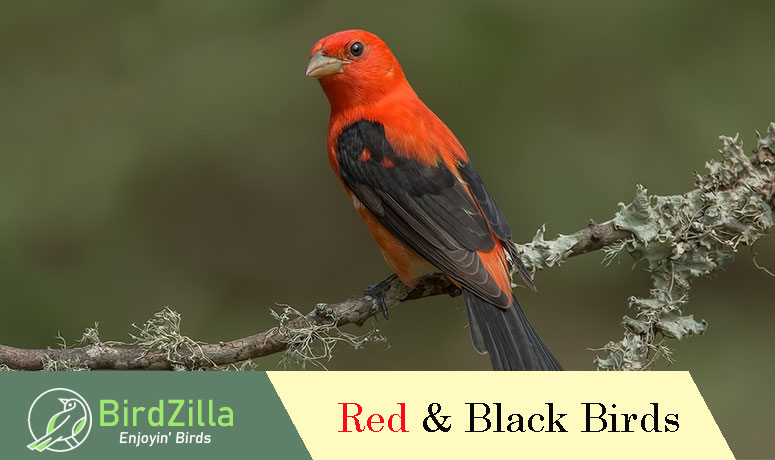
Red and black birds are some of the more eye-catching species of the avian landscape. Although there are fewer bird species with red and black than some other color combinations, birds with this striking pattern occur in most parts of the world.
In North America, we have a few common species with red and black plumage. These include garden birds like the Northern Cardinal and open country species like the Red-winged Blackbird.
These and other birds have striking combinations of red and black for the same reasons we like to watch them. Such colors are meant to catch the eye of female birds and make an impression.
As with other birds, the brighter a male bird is, the more likely a female will choose him to be a mate.
See ten of these beautiful red and black birds from North America below. Most of these impressive species are common, and some are regular visitors to feeders and backyards!
On this page
#10 Red-headed Woodpecker
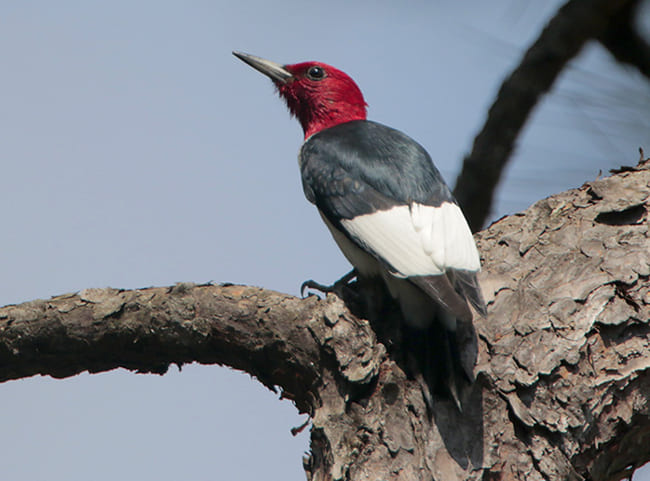
The Red-headed Woodpecker is a striking, eye-catching bird. This woodpecker has a beautiful red head, and a black back, wings, and tail. The rest of the underparts and the rump are bright, snowy white, and the long wings have a prominent white patch.
It also has a pointed, blue-gray bill with a dark tip, and a bit of black near the base of the bill. Young birds are somewhat similar to adults but are more grayish than black, and have brownish-gray heads.
This beautiful bird lives in semi-open oak woodlands and other open habitats in parts of southern Canada, and the central and eastern USA.
#9 Pyrrhuloxia
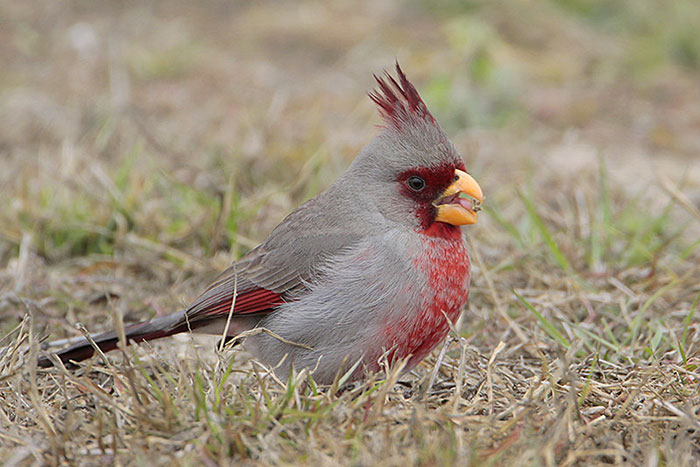
Photograph © Greg Lavaty
The Pyrrhuloxia is a cardinal species with an upright, pointed crest, and a conical, stout yellowish bill. The male is gray with red on the face, throat, crest, and in the wings and tail.
It also has a thick red line that extends from the throat to the lower belly. The female is duller, grayish-brown, and only has bits of red in the crest, face, wings, and tail.
Also known as the “Desert Cardinal”, the Pyrrhuloxia lives in arid habitats in Arizona, New Mexico, Texas, and Mexico.
#8 Lewis’s Woodpecker
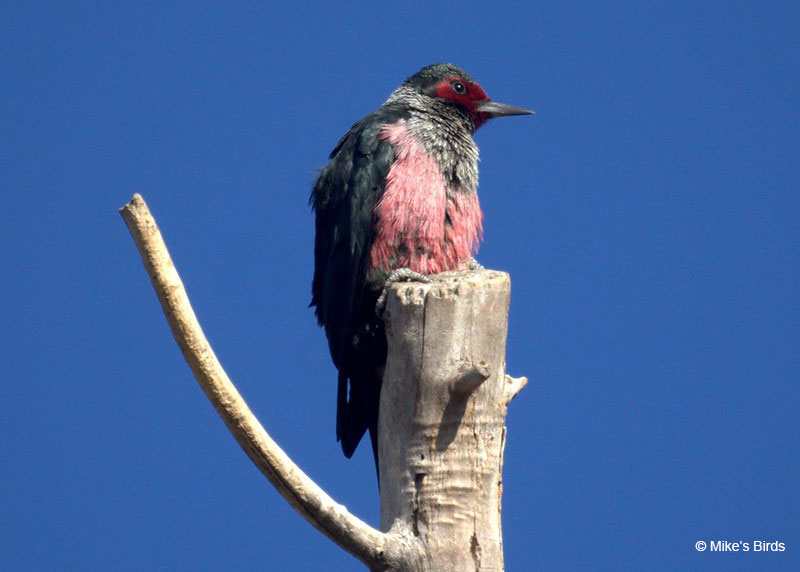
© Mike’s Birds
The Lewis’s Woodpecker is a fairly large woodpecker with a dark, blackish-green head and a dark red face. Around the same size as a Blue Jay, this woodpecker has a long, black bill.
It also has a silver collar and breast, and silver highlights on pink underparts. There is some black on the lower belly and dark green iridescence on its blackish wings, back, and tail.
The Lewis’s Woodpecker lives in open habitats and semi-open woodlands in the western USA, and part of southern British Columbia. It uses its long wings to fly up from a perch and catch flying insects.
#7 Pileated Woodpecker

© Alan D. Wilson
The Pileated Woodpecker is a big, crow-sized, crested woodpecker. This large woodpecker is mostly black with a white throat, white on the face and side of the neck, and has patches of red on its head.
The male has red from the bill to the back of the crest, and a red mustache. The female only has red on the top of the head and crest. In flight, the Pileated Woodpecker also shows a large white patch in the wing.
Pileated Woodpeckers live in forests in Canada, much of the eastern USA, and in the Pacific Northwest.
#6 Tricolored Blackbird
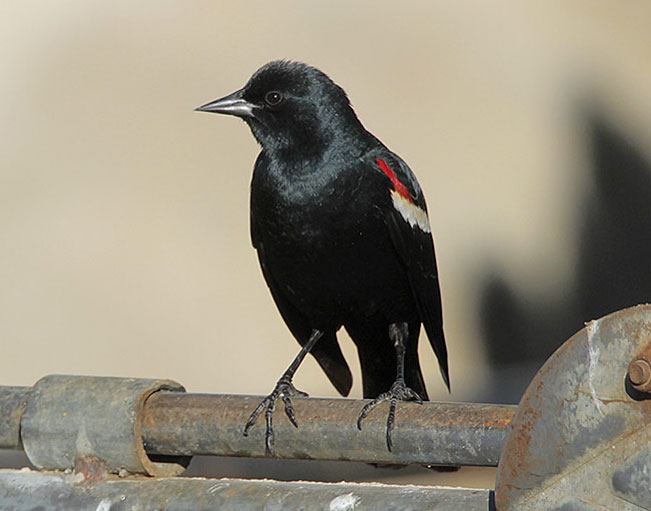
The male Tricolored Blackbird is a glossy black bird with a small, plush red patch in the wings. This red patch is bordered with white, in the shoulder of the wing, and is most obvious when the male is in flight or displaying.
Female Tricolored Blackbirds lack red and are blackish-gray with some pale mottling. Young male Tricolored Blackbirds are also dark blackish-gray but have some orange markings in the wings.
Flocks of this species nest in dense marshes and brushy habitats near water. Large flocks also forage in farmlands and other open habitats. This endangered species is nearly restricted to California, especially the Central Valley. Some also live in eastern Washington, Oregon, and Mexico.
#5 Rose-breasted Grosbeak
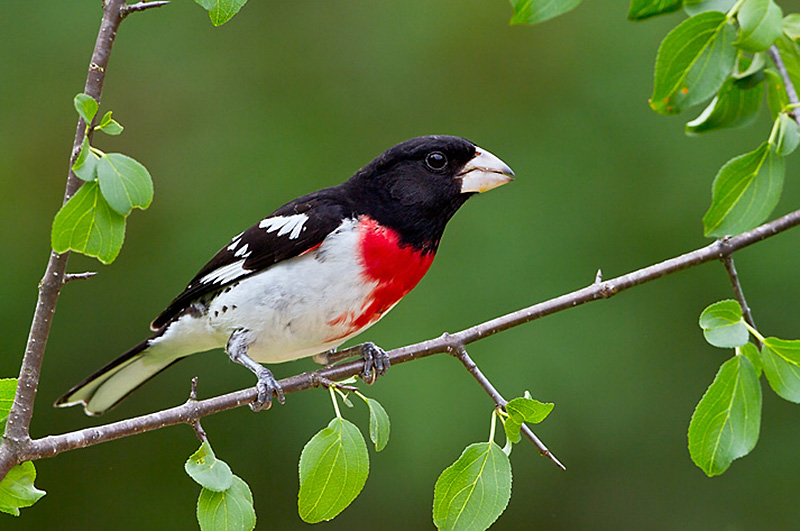
Photograph © Glenn Bartley.
The male Rose-breasted Grosbeak is a striking black and white bird with a bright red patch on its breast. This chunky bird also has a large, conical white beak and slightly forked tail. In flight, the rounded wings show obvious white patches and flashes of red on the underwing.
Female Rose-breasted Grosbeaks are brown and white, sparrow-like birds with pale eyebrows. They lack the black and red of the male and have some brown streaks on white underparts.
The Rose-breasted Grosbeak breeds in woodlands in central and southern Canada, the northern USA west to Kansas, and in the Appalachians.
#4 Vermilion Flycatcher
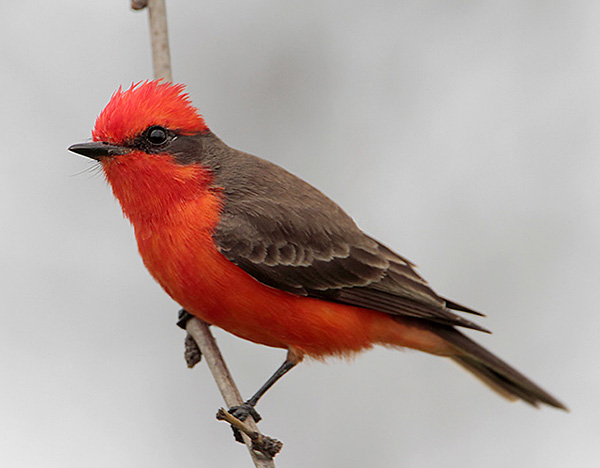
The male Vermilion Flycatcher is a sparrow-sized, black and red flycatcher with a short, puffy crest. The male is black above with red on the head, has a narrow black mask, and is red below.
The female Vermilion Flycatcher looks completely different. She is gray above, has a pale eyebrow, and white and pink (or pale yellow) underparts with gray streaks.
This conspicuous bird sallies insects from perches next to ponds, streams, and rivers in arid habitats. It lives in Texas, the southeastern USA, Mexico, and in Central and South America.
#3 Elegant Trogon
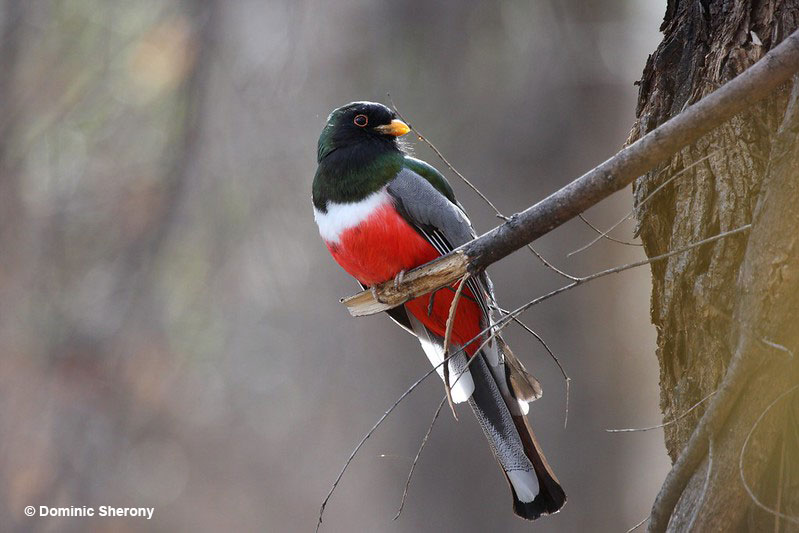
The male Elegant Trogon is iridescent golden-green above and mostly red below. It has a narrow red eyering and a black face and throat.
This species also has a white band separating a dark green and black breast from its red belly. The underside of its elongated, rectangular tail is white with some faint, black mottling.
The Elegant Trogon also has a stout yellow bill, and pale gray and black wings. The female Elegant Trogon is brown instead of green, has some white on the face, and has a pinkish belly.
This species lives in oak woodlands in southeastern Arizona, adjacent to New Mexico, Mexico, and Central America.
#2 Scarlet Tanager
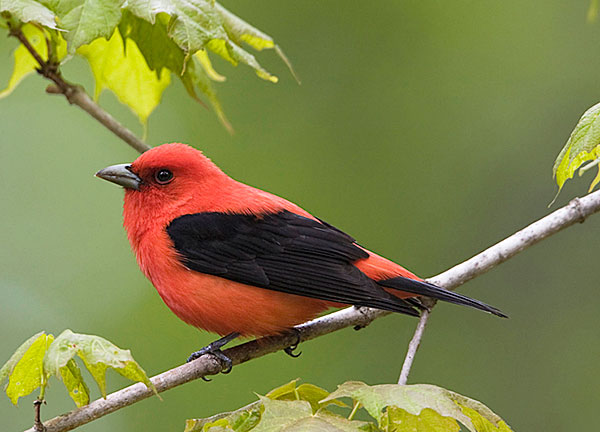
The male Scarlet Tanager is a thrush-sized bird with eye-catching, bright red plumage. The scarlet hues make a stark contrast against the velvet black tail, wings, and eyes. Female Scarlet Tanagers don’t have any red at all. Instead, they are yellow-olive with dusky wings and tail.
The breeding male is unmistakable but, in fall, has olive instead of red plumage. Even then, this tanager can be recognized by its black wings and tail.
The female is often confused with the female Summer Tanager. However, the female Summer is more uniform, yellowish, and has a larger, pale bill.
Scarlet Tanagers breed in deciduous and mixed woodlands. They live in southeastern Canada and much of the eastern USA. This species uses its long wings to migrate to South America.
#1 Northern Cardinal
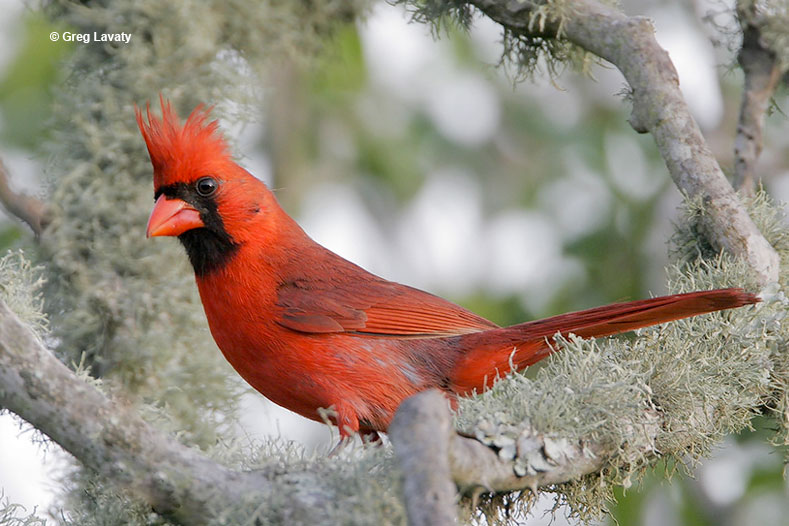
One of the classic “Redbirds“, the Northern Cardinal is a crested, finch-like bird colored with red, orange, and black. The male is bright red with a jet-black face, and large, conical reddish beak. He has duller shades of red on the back, wings, and tail.
The female Northern Cardinal also has a crest and conical bill but is mostly brown and buff. However, she still brightens feeders with an orange beak and red highlights in the crest, wings, and tail.
This popular and beautiful bird lives in gardens, second growth, and brush. We find it from southern Ontario west to Kansas and Arizona, and south to Mexico.


Ila tyler
Wednesday 24th of April 2024
I live in Mississippi and have Rose breasted grosbeak birds here. I have never seen these here. Both male and female.
Patrick O'Donnell
Wednesday 24th of April 2024
@Ila- How nice to have those beautiful birds at your place!